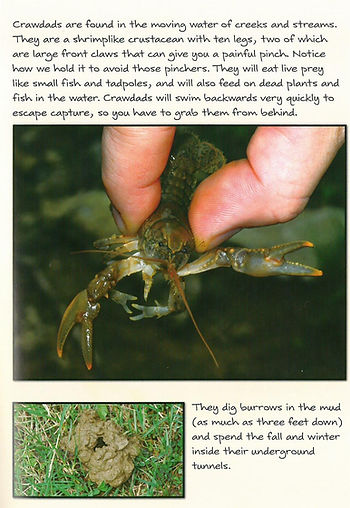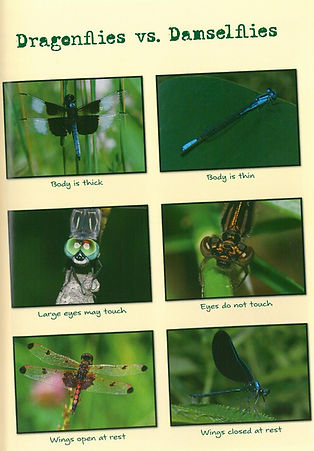
Click this file to read a great article about the Washed Ashore Project and see some amazing sculptures made from ocean trash!
Click this file to read a great article about the Washed Ashore Project and see some amazing sculptures made from ocean trash!
Click this file to read a great article about the Washed Ashore Project and see some amazing sculptures made from ocean trash!

FRESHWATER MACRO INVERTEBRATES

Click on this PDF to read a great article about crayfish!!!
Click on this PDF for some more crayfish info
CRAYFISH FACTS
There are 315 species of crayfish in North America. The average life span of a crayfish is between 2-6 years, but crayfish may live longer in captivity when they are well cared for. Crayfish prefer shallow, cool, running bodies
of water. Crayfish are omnivores and will eat small fish, tadpoles, other invertebrates and also dead plants. Some crayfish dig underground burrows to live in throughout the late fall and winter.
WATER QUALITY TOLERANCE:
Crayfish are considered facultative (this means they are in our middle column, somewhat tolerant to pollution). They are however sensitive to some toxic substances including metals and insecticides.
https://www.ecospark.ca/crayfish
http://kids.britannica.com/comptons/article-9602814/crayfish
http://www.biokids.umich.edu/critters/Crustacea/

Click on this link for some great information on dragonflies from the book: Bugs and Bugsicles
DRAGONFLY FACTS
There are 300 different species of dragonfly living in North America. Most people believe that dragonflies sting, but they are actually not capable of stinging and are quite harmless to humans. Click the links below for some great dragonfly resources.
WATER QUALITY TOLERANCE:
Depending on the species, dragonflies can be in all three taxa for water quality. The green darner dragonfly is very sensitive to pollution, the club-tail dragonfly is somewhat tolerant, and the pennant dragonfly is tolerant.
https://www.ecospark.ca/dragonfly
http://www.smithsonianmag.com/science-nature/14-fun-facts-about-dragonflies-96882693/?no-ist


There are about 69 species of leeches in North America. Leeches are segmented worms. They are most commonly found in freshwater, but there are a few species of marine (ocean environments) and terrestrial (living on land) leeches as well. All leeches feed on the fluids of other organisms, some pierce and kill their prey to obtain fluid, others are parasitic and suck fluid from prey, but seldom kill them. Leeches move by anchoring themselves to the ground, rocks or other items using their suckers both front and back. Leeches have been used in medicine to help with blood flow as well as research for anesthetics.
WATER QUALITY TOLERANCE:
Leeches are tolerant. They are mostly tolerant to low levels of dissolved oxygen which means that if you find many leeches present and not other invertebrates, the testing site is most likely polluted.
http://www.biokids.umich.edu/critters/Hirudinea/
LEECH FACTS



CADDISFLY FACTS
There are about 1400 species of caddisflies in North America. Caddisflies are aquatic as larvae and pupae and terrestrial as adults. This means that they live in the water as young and on land as adults. Caddisflies are extremely important in the aquatic ecosystem as they provide food for many species of fish. Caddisflies are also extremely important when studying pollution in freshwater. Most species of caddisflies are nocturnal and spend their days hiding in moist environments. All caddisfly larvae produce silk which they use to build protective shelters. The free living caddisfly only constructs shelter for the purpose of pupation.
WATER QUALITY TOLERANCE:
Similar to dragonfly nymphs, because there are so many different species of caddisfly, it depends on what type of caddisfly larva when determine pollution tolerance. Most caddisfly larva are sensitive, but there are some like, the northern casemaker, trumpetnet or tubemaking caddisflies that are somewhat tolerant to pollution.
https://wiflyfisher.com/Lifecycle-of-Cadddisflies.asp
https://www.ryenaturecenter.org/nature-news-articles/2020/3/30/sgnn9w1pkakoubxoe7bulei1g3ai8q
https://www.ecospark.ca/caddisfly
http://lifeinfreshwater.net/caddisfly-larvae-trichoptera/
http://www.cabinetmagazine.org/issues/25/duprat.php

SNAIL FACTS
There are about 500 species of freshwater snails in North America. Snails are divided into two groups, gilled snails also called prosobranchs and lunged or pouch snails also called pulmonates.
WATER QUALITY TOLERANCE:
Most gilled snails are in our middle column on our data sheet. They are somewhat sensitive to pollution. Lunged snails are tolerant to pollution. Since they breathe air, they do not need dissolved oxygen and can live in water that has nutrient pollution.
http://lifeinfreshwater.net/cat/molluscs/
http://www.biokids.umich.edu/critters/Gastropoda/

A great resource for information on all macro invertebrates is: A Guide to Common Freshwater Invertebrates of North America by J. Reese Voshell, Jr.
Photo credit for all critter pictures to scientific illustrator Gina Mikel please visit her website at http://www.scientificillustrator.com to see more great images and learn about her work.
